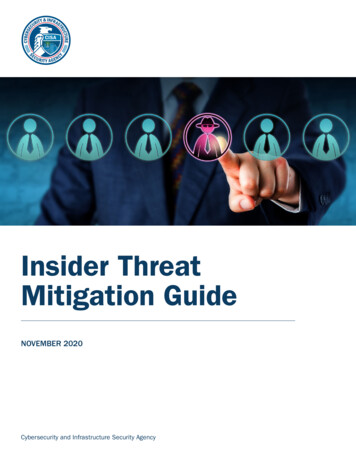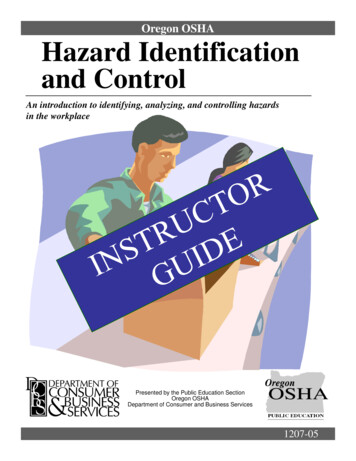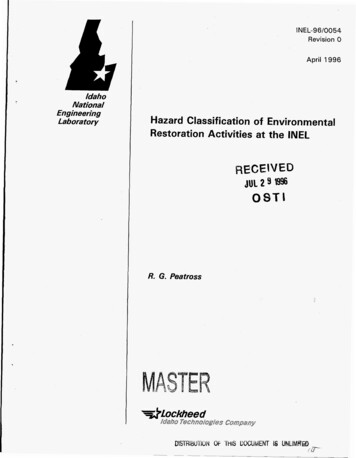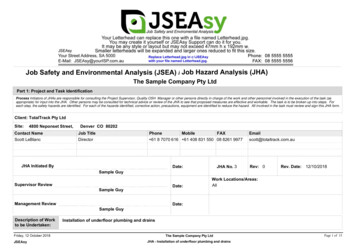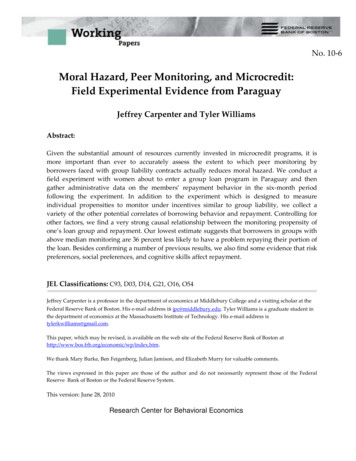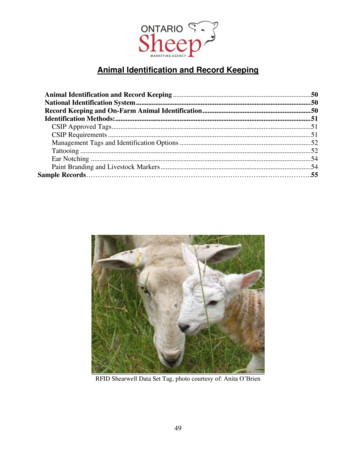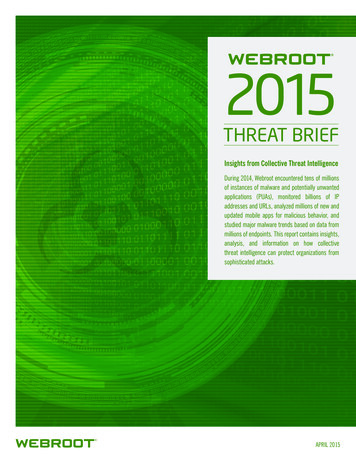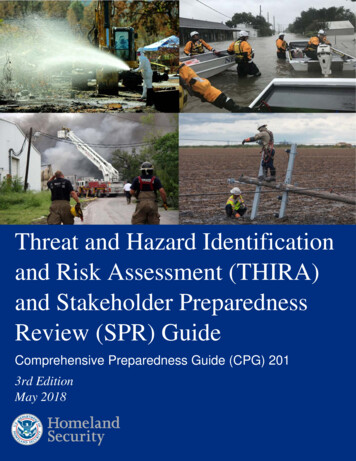
Transcription
Threat and Hazard Identificationand Risk Assessment (THIRA)and Stakeholder PreparednessReview (SPR) GuideComprehensive Preparedness Guide (CPG) 2013rd EditionMay 2018
CPG 201: THIRA/SPR Guide—3rd Edition2
PrefaceCPG 201: THIRA/SPR Guide—3rd EditionPrefaceComprehensive Preparedness Guide (CPG) 201, 3rd Edition, provides guidance for conducting aThreat and Hazard Identification and Risk Assessment (THIRA) and Stakeholder PreparednessReview (SPR), formerly State Preparedness Report. The 1st Edition of CPG 201 (April 2012)presented the basic steps of the THIRA process. Specifically, the 1st Edition described astandard process for identifying community-specific threats and hazards and setting targets foreach core capability identified in the National Preparedness Goal. The 2nd Edition (August2013) expanded the THIRA process to include resource estimation, streamlined the number ofsteps in the process, and provided additional examples of how to develop a THIRA.CPG 201, 3rd Edition, includes both the THIRA and SPR because they are interconnectedprocesses that, together, communities use to evaluate their preparedness. The 3rd Edition alsointroduces updates to both methodologies. The THIRA includes standardized language todescribe threat and hazard impacts and capability targets. This allows communities to collectmore specific, quantitative information while also providing important context. Through theupdated SPR process, communities collect more detailed and actionable data on their currentcapabilities and identified capability gaps. Communities then indicate their intended approachesfor addressing those gaps, and assess the impact of relevant funding sources on building andsustaining capabilities.Where appropriate, the 3rd Edition highlights key changes from previous editions of CPG 201.This 3rd Edition supersedes the 2nd Edition of CPG 201.3
CPG 201: THIRA/SPR Guide—3rd EditionTable of ContentsTable of ContentsContentsPreface . 3Table of Contents . 4Introduction . 5The National Preparedness Goal . 5The National Preparedness System . 6Using the THIRA/SPR Strategically. 7Community-Wide Involvement . 9The THIRA Process . 10Introduction to the Three Steps of the THIRA . 10Step 1: Identify the Threats and Hazards of Concern . 11Step 2: Give the Threats and Hazards Context . 15Step 3: Establish Capability Targets . 19The SPR Process. 23Step 1: Assess Capabilities . 24Step 2: Identify and Address Capability Gaps . 34Step 3: Describe Impacts of Funding Sources . 39Conclusion. 41Glossary of Terms . 424
IntroductionCPG 201: THIRA/SPR Guide—3rd EditionIntroductionThe National Preparedness GoalThe National Preparedness Goal, Second Edition (2015) 1 defines what it means for allcommunities to be prepared for the threats and hazards that pose the greatest risk to the securityof the United States. The National Preparedness Goal (“the Goal”) is:A secure and resilient Nation with the capabilities required across the whole community toprevent, protect against, mitigate, respond to, and recover from the threats and hazards thatpose the greatest risk.The Goal identifies 32 distinct activities, called core capabilities, needed to address the greatestrisks facing the Nation (see Figure 1). 2 The Goal organizes these core capabilities into fivecategories, called mission areas. 3 Some core capabilities apply to more than one mission area.For example, the first three core capabilities—Planning, Public Information and Warning, andOperational Coordination—are cross-cutting capabilities, meaning they apply to each of the fivemission areas.The National Preparedness Goal describes the five mission areas as follows: Prevention: Prevent, avoid, or stop an imminent, threatened, or actual act of terrorism. Protection: Protect our citizens, residents, visitors, and assets against the greatestthreats and hazards in a manner that allows our interests, aspirations, and way of life tothrive. Mitigation: Reduce the loss of life and property by lessening the impact of futuredisasters. Response: Respond quickly to save lives; protect property and the environment; andmeet basic human needs in the aftermath of an incident. Recovery: Recover through a focus on the timely restoration, strengthening, andrevitalization of infrastructure, housing, and a sustainable economy, as well as thehealth, social, cultural, historic, and environmental fabric of communities affected by anincident.The mission areas and core capabilities organize the community-wide activities and tasksperformed before, during, and after disasters into a framework for achieving the goal of asecure and resilient Nation.1For additional information on the National Preparedness Goal, please visit: r additional information on core capabilities, please visit: https://www.fema.gov/core-capabilities.3For additional information on mission areas, please visit: https://www.fema.gov/mission-areas.5
CPG 201: THIRA/SPR Guide—3rd EditionIntroductionFigure 1: Five mission areas organize the 32 core capabilities needed to address threat and hazards ofconcern.The National Preparedness SystemCommunities assess, build, sustain, and deliver the core capabilities through an organizedprocess called the National Preparedness System. 4 The National Preparedness System has sixcomponents (see Figure 2), each of which ties into the others to guide community-widepreparedness activities and achieve the Goal of a secure and resilient Nation.4For additional information on the National Preparedness System, please visit: https://www.fema.gov/nationalpreparedness-system.6
IntroductionCPG 201: THIRA/SPR Guide—3rd EditionFigure 2: There are six components of the National Preparedness System.Using the THIRA/SPR StrategicallyThe THIRA/SPR sets a strategic foundation for putting the National Preparedness System intoaction. Communities complete the THIRA every three years and use the data from the process toassess their capabilities in the SPR, which is an annual review. It is important that communitiescomplete the THIRA on a multi-year cycle, as it enables them to assess year-over-year trends inchanges to their capabilities, while still periodically reviewing the capability targets to keep themrelevant.The three-year THIRA/SPR cycle starts with the first step in the National Preparedness System:Identifying and Assessing Risk. Risk is the potential for an unwanted outcome resulting from anincident or occurrence, as determined by its likelihood and the associated consequences. 5 In theTHIRA, communities identify risks with the potential to most challenge their capabilities andexpose areas in which the community is not as capable as it aims to be. These areas, or capabilitygaps, create barriers in a community’s ability to prevent, protect against, mitigate, respond to, andrecover from a threat or hazard. Understanding the risks they face will make it easier forcommunities to determine what level of capability they should plan to build and sustain.Communities can use the information that comes from the THIRA/SPR process to answer fivekey strategic questions about their preparedness risks and capabilities (see Figure 3).5DHS Risk Lexicon, June 2010: ns/dhs-risk-lexicon-2010 0.pdf.7
CPG 201: THIRA/SPR Guide—3rd EditionIntroductionFigure 3: Communities use the THIRA/SPR to answer five key questions.Since 2012, communities have used the THIRA/SPR to answer these questions, helping thembetter understand the risks their communities face. This helps communities make importantdecisions on how to prevent, protect against, mitigate, respond to, and recover from the threatsand hazards that pose the greatest risks.In addition to the Identifying and Assessing Risk component of the National PreparednessSystem, communities use the THIRA/SPR for Estimating Capability Requirements. Thisinvolves determining the specific level of capability that best addresses a community’s risks.These community-specific capability levels are what communities use to determine their currentlevel of capability, identify their capability gaps, and identify how they can close those gaps. Atthe end of the three-year THIRA/SPR cycle, communities reassess their risks by completing theTHIRA again and the process restarts. The outputs of the THIRA/SPR provide communities afoundation to prioritize decisions, close gaps in capability, support continuous improvementprocesses, and drive the other National Preparedness System components (see Figure 4).8
IntroductionCPG 201: THIRA/SPR Guide—3rd EditionFigure 4: The THIRA/SPR fuels NPS implementation.Community-Wide InvolvementRecognizing that preparedness is a shared responsibility, the National Preparedness System callsfor everyone—not just government agencies—to be involved in preparedness efforts.Community-wide involvement is an important principle in preparedness that entails involvingstakeholders throughout preparedness development, and ensuring preparedness materials reflecttheir roles and responsibilities. Including stakeholders early on and throughout the THIRA/SPRprocess helps the community to conduct accurate and comprehensive assessments. Furthermore,involving stakeholders throughout the process empowers them to use the data to help drivepriorities and investments within their own organizations.As such, developing a comprehensive and accurate THIRA/SPR requires active communityinvolvement from stakeholders and subject-matter experts (SMEs), such as: Colleges/universities, and other research organizations Cybersecurity experts Emergency management/homeland security agencies Emergency Planning Committees Federal agencies (e.g. Department of Health and Human Services) FEMA regional offices Fire, police, emergency medical services, and health departments Hazard mitigation offices Infrastructure owners and operators Major urban area and state fusion centers National Laboratories National Weather Service offices Port or transit organizations Supply chain stakeholders Private sector partners (including the 16 critical infrastructure sectors)9
CPG 201: THIRA/SPR Guide—3rd Edition The THIRA ProcessProfessional associationsTribal governmentsU.S. Department of Homeland Security (DHS) Protective Security AdvisorsVolunteer Organizations Active in Disasters (VOAD)Other organizations or agencies with significant impact on the local economyCommunities should also include SMEsImportance of Community-Wide Involvementfrom planning, exercises, mitigation,training, and other key areas in theirThe outputs of the THIRA/SPR process informTHIRA/SPR process. Including theall other preparedness activities; helpingperspectives and expertise of these keycommunities identify challenges, drive priorities,stakeholders gives communities criticaland close gaps in capabilities. Therefore, wheninformation regarding planning factorsdeveloping and updating THIRA/SPRs,and capability levels across all missioncommunities should ensure their assessment andareas. As a result, emergency managersplanning efforts include community-wide inputwill be well-positioned to provideand perspectives.essential information about the status ofcapabilities and consider THIRA/SPR data in their planning efforts, including the developmentof strategic, operational, and tactical plans.The THIRA ProcessIntroduction to the Three Steps of the THIRAThe THIRA is a three-step risk assessment completed every three years. It helps communitiesanswer the following questions: What threats and hazards can affect our community?If they occurred, what impacts would those threats and hazards have on our community?Based on those impacts, what capabilities should our community have?The THIRA helps communities understand their risks and determine the level of capability theyneed in order to address those risks. The outputs from this process lay the foundation fordetermining a community’s capability gaps during the SPR process.This section describes the three-step process for developing a THIRA (see Figure 5):Figure 5: There are three steps in the THIRA process.10
THIRA Step 1CPG 201: THIRA/SPR Guide—3rd Edition1. Identify Threats and Hazards of Concern: Based on a combination of experience,forecasting, subject matter expertise, and other available resources, develop a list of threatsand hazards that could affect the community. When deciding what threats and hazards toinclude in the THIRA, communities consider only those that challenge the community’sability to deliver at least one core capabilityTHIRA: Key Changesmore than any other threat or hazard; theTHIRA is not intended to include less FEMA now recommends thatchallenging threats and hazards.communities complete the THIRA on athree-year cycle, rather than annually.2. Give Threats and Hazards Context:Describe the threats and hazards identified inStep 1, showing how they may affect thecommunity and create challenges inperforming the core capabilities. Identify theimpacts a threat or hazard may have on acommunity. The THIRA is now a three-stepassessment; FEMA has removedTHIRA Step 4—Apply Results—fromthe process.3. Establish Capability Targets: Using the impacts described in Step 2, determine the level ofcapability that the community plans to achieve over time in order to manage the threats andhazards it faces. Using standardized language, create capability targets for each of the corecapabilities based on this desired level of capability by identifying impacts, objectives, andtimeframe metrics.Step 1: Identify the Threats and Hazards of ConcernIn Step 1 of the THIRA process, communities develop a list of threats and hazards (see Figure6).Figure 6: The output of Step 1 of the THIRA is a list of threats and hazards of concern.Categories of Threats and HazardsFor the purposes of the THIRA, threats and hazards are organized into three categories. Natural hazards: acts of natureTechnological hazards: accidents or the failures of systems and structuresHuman-caused incidents: the intentional actions of an adversaryTable 1 provides example threats and hazards for each of the three categories.11
CPG 201: THIRA/SPR Guide—3rd EditionTHIRA Step 1Table 1: Example threats and hazards by Dam failureActive shooter incidentDroughtHazardous materials releaseArmed assaultEarthquakeIndustrial accidentBiological attackEpidemicLevee failureChemical attackFloodMine accidentCyber-attack against dataHurricane/TyphoonPipeline explosionSpace weatherRadiological releaseCyber-attack againstinfrastructureTornadoTrain derailmentTsunamiTransportation accidentVolcanic eruptionUrban conflagrationWinter stormUtility disruptionExplosives attackImprovised nuclear attackNuclear terrorism attackRadiological attackCommunities consider two criteria whenThe Most Challenging Threat or Hazardidentifying threats and hazards for theFor the purposes of this Guide, if a threat orassessment: (1) the threat or hazard ishazard“most challenges” a core capability, itreasonably likely to affect the community;means that the community would struggle toand (2) the impact of the threat or hazarddeliver the core capability during that specificchallenges at least one of the 32 coreincident more so than for any other threat orcapabilities more than any other threat orhazard.hazard. As a single incident may mostchallenge the ability to perform multiplecore capabilities, the number of threats and hazards that each community includes will dependon the specific risk profile of the community.See Figure 7 for an example where a community selected an earthquake, a cyber-attack, a flood,an active shooter, and a chemical hazmat release—each of which most challenged at least onecore capability.12
THIRA Step 1CPG 201: THIRA/SPR Guide—3rd EditionFigure 7: A single threat or hazard may most challenge more than one core capability.Sources of Threat and Hazard InformationConsulting multiple sources during the THIRA process helps establish a comprehensive list ofthe threats and hazards that communities may face. These sources may include, but are notlimited to: Existing Federal, state, local, and tribal strategic and operational plansExisting threat or hazard assessments (e.g., the Hazard Identification and RiskAssessment)Forecasts or models of future risks due to changing weather and demographic patterns oremerging threatsHazard mitigation plansIntelligence fusion center bulletins and assessmentsLocal, regional, tribal, and neighboring community THIRAsRecords from previous incidents, including historical dataHomeland security and emergency management laws, policies, and proceduresPrivate-sector plans and risk assessments, including those for lifeline functions(communications, energy, transportation, and water) 6Factors for Selecting Threats and HazardsWhen identifying threats and hazards to include in the THIRA, communities consider two keyfactors: (1) the likelihood of a threat or hazard affecting the community; and (2) the challengepresented by the impacts of that threat or hazard, should it occur.6Lifeline functions are functions that are essential to the operation of most critical infrastructure sectors. Foradditional information on lifeline functions please 013-508.pdf.13
CPG 201: THIRA/SPR Guide—3rd EditionTHIRA Step 1Factor #1: Likelihood of a Threat or Hazard Affecting a CommunityFor the purposes of the THIRA, “likelihood” is the chance of a given threat or hazard affecting acommunity. Likelihood is important to consider because communities must allocate limitedresources strategically. A particular threat or hazard might be possible, but communities shoulddetermine whether the likelihood of its occurrence is large enough to drive investment decisions.Through the THIRA, communitiesConsidering the Location of Threat and Hazardidentify the threats and hazards thatConsequencesare challenging enough to exposetheir capability gaps, and are likelyAlthough incidents may have wider regional or nationalenough that a community caneffects, communities completing the THIRA shouldjustify investing in the capabilitiesfocus strictly on the consequences within theirnecessary to manage those threatscommunity. In some cases, it may be useful to includeand hazards.threats and hazards that occur in other locations if theytrigger local effects.The ability to predict the likelihoodof a specific incident varies greatlyFor Example:across threats and hazards. SomeAn industrial accident at a chemical plant located in onehazards, such as floods, haveparticular community could affect people in anothermature prediction models that cancommunity who are downwind or downriver from theallow communities to calculate theaccident.numerical probability of a specificincident, such as 1 in 100 or 1 percent a year, with a moderate degree of accuracy. Otherincidents, such as terrorism, are more difficult to predict and communities may most easilyexpress them on a logarithmic scale, such as 1 in 1,000, or on an ordinal scale, such as low,medium, and high. Regardless of how communities express the probability of a specificincident, understanding the likelihood of their threats and hazards can help communitiesunderstand capability requirements and prioritize investments.Including estimates of probability in the THIRA is not necessary, but communities may do so ifthey deem it appropriate. Communities can also consider additional sources for useful likelihoodand consequence information to inform their threat and hazard selections, such as hazardmitigation plans. Regardless of whether probability is included in the THIRA process,communities only consider those threats and hazards that could realistically occur.Factor #2: The Impacts of a Threat or HazardThe projected impacts of threats and hazards determine the level of capability that a communitywill need to address those impacts. To understand their risks effectively, communities shouldidentify and select threats and hazards that have impacts that most challenge their communities,and therefore their capabilities. When assessing impact, it is important to consider that differentincidents present different types of challenges. In some cases, the sheer magnitude of theincident may be substantial. In other cases, there may be operational or coordinationcomplexities or economic and social challenges.Communities may include as many threats or hazards in their THIRA as they desire but should,at a minimum, include as many threats and hazards as needed to most challenge each of the 32core capabilities.14
THIRA Step 2CPG 201: THIRA/SPR Guide—3rd EditionStep 2: Give the Threats and Hazards ContextIn Step 2 of the THIRA process, communities create context descriptions and estimate theimpacts of the threats and hazards identified in Step 1 (see Figure 8). Context descriptions andimpacts inform THIRA Step 3 where communities determine the level of capability they wouldlike to achieve. When creating contextTHIRA Step 2: Key Changesdescriptions and estimating impacts,communities should consider community-wide Communities now identify the impactssources, such as real-world incidents, SMEs,for their chosen threats and hazards inexercises, response and recovery plans,Step 2, rather than Step 3, because thismodeling, or tools. Identifying different sourcesflows more naturally from developingprovides communities with key data points thatcontext descriptions.they can use to determine how a threat or hazard Communities now estimate the impactsmay affect their community. For example, SMEsof each threat and hazard usingcan help shape context descriptions by outliningstandardized impact languagethe time, place, and location of the threat or(numerical entry), rather than providinghazard in a way that shows how it challenges afree-text impacts, establishing acommunity’s capabilities.common language for describingIdentifying sources of information is extremelyimpacts at all levels of government.important for continuity of the assessmentprocess. Communities may not update the THIRA for several years, so there may be changes instaff involved in the process between updates. The potential resulting loss in knowledge andexperience after staff turnover can make it challenging to maintain continuity between updates.Citing sources helps to complete future THIRA updates, increasing consistency, improving datacredibility, and reducing duplication of effort.Figure 8: The outputs of Step 2 of the THIRA are context descriptions and impact numbers.Step 2.1: Context DescriptionsIn Step 2.1 of the THIRA, communities add context to each threat and hazard identified in Step1. Context Descriptions are the details about a threat or hazard needed to identify the impacts itwill have on a community and includes critical details such as location, magnitude, and timeof an incident.If an element of the scenario is essential to understanding the impact of an incident and thecapabilities required to manage it, that element should be included in the context description.15
CPG 201: THIRA/SPR Guide—3rd EditionTHIRA Step 2For example, at night, residential structures have a higher occupancy, while during the day,schools and office buildings have higher occupancies. In this example, search and rescuemissions would target different locations based on the time of the day the scenario occurs. SeeTable 2 for more examples on how critical details can influence a context description.Table 2: Questions to Consider When Developing Context DescriptionsBest Practices for Developing Context DescriptionsQuestions to ConsiderExamples in PracticeHow would the timing of an incident affect thecommunity’s ability to manage it? What time of dayand what season would be most likely or have thegreatest impact?Community A is a very popular summer touristdestination. A tornado occurring at 7:00 p.m. inJune might have the greatest impacts, as largenumbers of tourists will be on the roadsreturning to their hotels.How would the location of an incident affect thecommunity’s ability to manage it? Which locationswould be most likely or have the greatest impacts(e.g., populated areas, coastal zones, industrial orresidential areas)?Community B has a high population density inthe north and very low population density in thesouth. A pandemic might result in the greatestimpacts in the north, where the disease canspread among the population more quickly.What other conditions or circumstances make thethreat or hazard of particular concern (e.g.,atmospheric conditions like wind speed/directionand relative humidity, or multiple incidentsoccurring at the same time)?Community C experiences a hazardousmaterials release. The worst impacts mightoccur on a day with increased wind speeddirected towards the highly populatedresidential areas in the community.What social or physical vulnerabilities make thethreat or hazard of particular concern? (e.g., floodprone areas, populations with limited or no ability toevacuate)?Community D is located in a mountainousregion, with its population spread between thesuburban areas in the foothills and the ruralmountain communities. A wildfire might havegreater impacts in the mountain communities,which have limited roads that the populationcan use to evacuate and is more difficult toaccess by response workers.See the example context descriptions below for a comparison between sufficient and insufficientlevels of detail. The example with sufficient detail provides suggested types of information thata community might want to consider including in their context descriptions.Example Context Description: Insufficient Level of DetailAn active shooter incident occurs, involving multiple gunmen and many potential victims.There are dozens of fatalities and injuries, and first responders arrive to the scene quickly.There are reports that the incident may be related to terrorism.16
THIRA Step 2CPG 201: THIRA/SPR Guide—3rd EditionExample Context Description: Sufficient Level of DetailAt approximately 2:00 p.m. on a Sunday afternoon, local police and State Troopers aredispatched to Thiraland City Mall responding to reports of an active shooter situation. 9-1-1calls from patrons report between one and four shooters, with varying reports of the types ofweapons, number of weapons, and number of injured people. At the time of the incident—among the busiest the mall experiences during a normal week—the 1,200,000 square footfacility was occupied by approximately 8,500 shoppers and employees. Upon arrival,authorities find crowds pouring out of the mall’s exits. Some are unharmed while others areseverely injured. Advanced Life Support (ALS) and Basic Life Support (BLS) units are enroute, with mutual aid EMS being dispatched. Shots are still heard inside, and the injury countcannot be immediately estimated. The closest hospital facility is approximately 3 miles fromThiraland City Mall. The closest Level I Trauma Center is approximately 18 miles fromThiraland City Mall. The medical facilities have been notified of the incoming patients, butthe unknown number and extent of injuries, ongoing shortages of IV bags, and understaffingraise concern about the facilities’ ability to care for the incoming victims. Within an hour, thestate fusion center is receiving credible intelligence of a terrorism link to the attack.Step 2.2: Estimate ImpactsIn Step 2.2, communities estimate the impacts a scenario would have on their community if thethreat or hazard occurred. Communities write impacts in the language of common emergencymanagement metrics, such as affected population, number of people requiring shelter, ornumber of people requiring screening. The THIRA process uses a uniform set of these commonmetrics, or standardized impact language (see Figure 9). The standardized impact languagerepresents metrics estimated by every community, and in most cases, across multiple differentthreats and hazards. The estimated impact from this step provides the basis for creatingcapability target statements in Step 3 of the THIRA pr
The 1st Edition of CPG 201 (April 2012) presented the basic steps of the THIRA process. Specifically, the 1st Edition described a standard process for identifying community-specific threats and hazards and setting targets for each core capability identified in the National Preparedness Goal. The 2nd Edition (August

